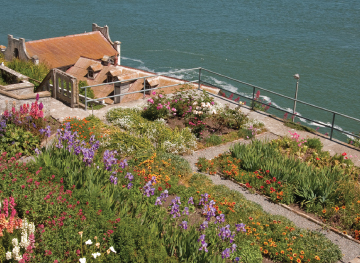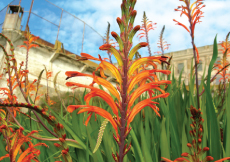The revitalized gardens of Alcatraz are worthy of a captive audience

A view of the gardens in bloom along Officers' Row
Photo: Elizabeth Byers
Photo: Elizabeth Byers
Gardens were first planted on Alcatraz by the U.S. Army in 1865. As an Army fort and later a military prison, the Rock was really all rock. Soil was brought from Angel Island and the Presidio to make the landscape look, well, not so bleak.
In the 1920s, an effort was made by the California Spring Blossom and Wildflower Association to beautify the prison grounds. The inmates assisted in planting hundreds of trees and bushes.
The federal Bureau of Prisons took over Alcatraz in 1933. Families were living on The Rock when it was a military installation and, later, when it was a federal prison.
“If a man was posted to Alcatraz, then his wife came along to this outpost to live here in the middle of San Francisco Bay,” said Corny Foster, who volunteered to work on the gardens one week after she retired as a management consultant with Bank of America. “To bring some civility to this barren place, Victorian-style gardens were permitted.”
In the early 1930s, Fred Reichel, secretary to the warden, convinced his boss to allow prisoners to do the gardening in the plots that were left by the Army.
“Getting to work in the garden was a form of escape,” said park ranger Benny Baton.
Reichel consulted with California horticulturists. Soon, a series of gardens were being cultivated around the island.
The prison was closed in 1963 by Attorney General Robert Kennedy – it was considered cruel and unusual treatment for inmates to be incarcerated there –and the gardens were abandoned. Many plants died and the weeds took over. From 1969 to 1971, Native Americans took over Alcatraz. They did not seem interested in maintaining any gardens.
The National Park Service took custody of Alcatraz in 1972. But it wasn’t until 2003 that a concerted effort to restore the gardens began. The Garden Conservancy, the Golden Gate National Parks Conservancy, and the National Park Service undertook this ambitious project. After eight years, the results are dramatic.
“We now have five garden areas at various levels of the island,” said Shelagh Fritz, project manager on Alcatraz. “Today we have more than 300 species of plants.”
Fritz also oversees the volunteers on The Rock. There is no shortage of people who want to dig in and get their hands dirty.
“Today, we have a group of volunteers from MTV,” explained Fritz. “We get lots of young people out here volunteering. Who wouldn’t want to say that you’d been gardening on Alcatraz all day? It’s cool.”

Cobra lilies in bloom on Alcatraz
Photo: National Park Service
Photo: National Park Service
A permanent volunteer is Dick Miner, a retired AIDS researcher from Marin. His specialty is compost. In fact, his compost has taken a few awards at the Marin County Fair. You can’t say that about just anyone.
“We call him ‘The Worm Man of Alcatraz’,” Fritz said cheerfully and with obvious affection.
Fritz is happy with the way things are going. “Look at this blanket of pink blossoms,” she said, pointing proudly to the ice plants. “You can see the bright pink from the Marina and Pacific Heights. Isn’t that great?”
To volunteer in the gardens and help bring more color to Alcatraz, e-mail [email protected] or call 415-561-3077.


